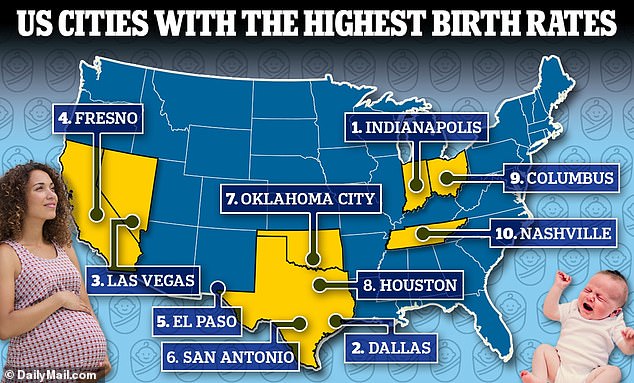Midwestern Americans appear to be the busiest in bed, a new analysis shows.
Researchers at a financial technology company Smart asset reviewed census data from 37 major U.S. cities to determine which had the highest and lowest birth rates.
The team looked at the number of women in each city between the ages of 15 and 50 who had a baby between 2021 and 2022, then compared the data to the total number of women in that age group in each city.
Indianapolis, home of the Indy 500, topped the list, with 6.5 percent of women giving birth in 2022, equivalent to just under 14,500 births.
Dallas and Las Vegas followed closely behind, with 6.3 percent women and 6.1 percent men, respectively.
Meanwhile, Seattle came in last place, with only 2.6 percent of women ages 15 to 50 having a baby in 2022: 5,760.
Despite their relatively high figures in the analysis, overall birth rates in major cities still remain below the national average (1.6 births per woman), which has fallen to its lowest level in more than 100 years.
Indianapolis’ top spot could be due to the influx of people coming to the area from major cities like New York and Los Angeles.
An analysis by Indiana University, for example, found that the state gained nearly 30,000 new residents in 2023. And that same year, there were 7,510 more births than deaths. In 2022, there were 22,500 new residents.
Census data suggests that New York City lost 78,000 residents in 2023 and that the Los Angeles metropolitan area had 71,000 people flee.
Matthew Kinghorn, a senior demographer at Indiana University, said of that data: “Indiana’s growth was driven by another year of exceptionally high net immigration.”
According to the study, the fastest growing counties were those surrounding Indianapolis.
In 2022, Indianapolis’ birth rate increased from 5.8 percent in 2021. However, the average family size was 3.12, down slightly from 3.24 in 2021.
In Dallas, the average family size was 3.3 and the birth rate increased slightly from 6.1 percent in 2021 to 6.3 percent in 2022.
And the rate in Las Vegas also increased, growing to 6.1 percent from 4.4 percent in 2021. The average family size there was 3.3.
Fresno and El Paso rounded out the top five, both with 5.9 percent of women having a baby in 2022.
In Fresno, this resulted in 7,955 births, along with 9,757 in El Paso.

Experts have warned that while birth rates are rising in some major cities, the national birth rate has long been declining.
The average family size in Fresno was 3.6, while in El Paso it was 3.4.
The average family size in the United States is 3.13 members, according to the U.S. Census Bureau.
Texas dominated the top 10, with four cities with the highest birth rates: Dallas, El Paso, San Antonio and Houston.
However, its main city, Austin, had the fifth-lowest birth rate, at 3.8 percent.
Meanwhile, Seattle ranked last for birth rate. The average family size was just 2.8, down from 3.4 percent in 2021.
This low rate could be due to the high cost of living in Seattle as the city is a hub for career-oriented people, such as those who work in technology.
Milwaukee, Boston, Portland and Austin rounded out the rest of the bottom five.
Large cities have long had lower birth rates than suburban or rural areas. This is often due to a higher cost of living, better access to contraception, and less space to accommodate large families.
In the United States, overall birth rates are also declining. In 2007, the birth rate was 14.3 births per 1,000 people nationwide. In 2022, the last year with data, this figure had dropped to just 11.1 per 1,000 people.
Experts believe this decline is due to many Americans choosing to focus on work instead of family, as well as a higher cost of living.


